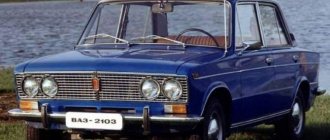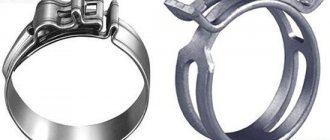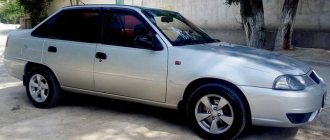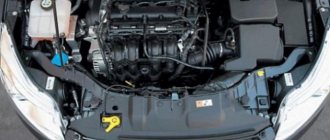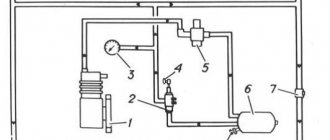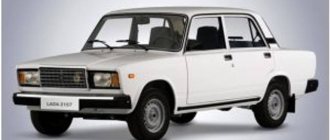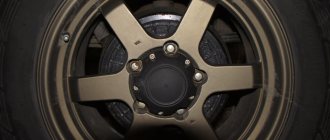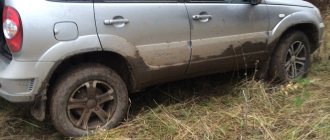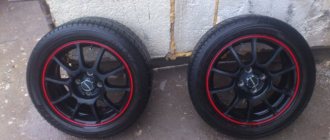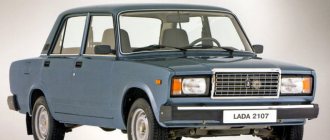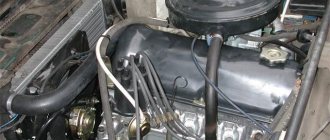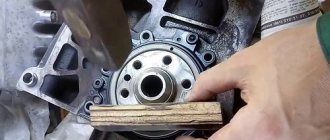When choosing wheels for a VAZ, you need to look not only at their appearance, but also at the possibility of using them on a particular model. In addition, certain technical characteristics must be taken into account.
The most important of them are:
- bolt pattern;
- diameter;
- departure;
- fastening elements;
- diameter of the centering hole.
Quick answer: Which bolt pattern is suitable for the VAZ 2107?
The design of the “seven” provides for a “98x4” wheel bolt pattern - fastening with four bolts, the holes of which are located on a circle with a diameter of 98 millimeters. Many foreign cars have a close bolt pattern - 100x4. In the first case, the distance between the centers of the bolts is 69.3 mm, in the second - 70.7 mm.
What wheels can be installed on a VAZ 2107?
It is allowed to install wheels of sizes R13, R14 on any VAZ 2107 car. According to the production method, this can be either stamping or casting.
What wheels are suitable for Lada cars?
For a VAZ 2106 car, therefore, R13, R14 wheels and 165/70 or 175/70 tires will be recommended.
What kind of bolt pattern does a Lada have?
Bolt pattern of Zhiguli wheels
All Volga cars have a Fiat 4*98 bolt pattern. This means that the disc is secured with four bolts, and the diameter of the circle (PCD) around which the mounting holes are located is 98 millimeters.
What drives come with the 2107?
In other words, the VAZ 2107 will fit wheels with an offset from + 24 to + 34 mm. The amount of overhang is measured in millimeters and is indicated on the marking as follows: ET 29, ET 30, ET 33, etc.
What wheels can be installed on a Lada?
It is allowed to install wheels of sizes R13, R14 on any VAZ 2107 car. According to the production method, this can be either stamping or casting.
What are the maximum wheels that can be installed on a VAZ 2107?
The permissible size of disks can reach 5.5J-6.0J × 14 ET29-32. Those drivers who dream of wide rims can set the size to 6.5J with a 23 mm offset, but they need to be prepared that the front wheels will definitely catch on the fender liner when cornering.
What wheels are suitable for the VAZ 2105?
Table of tire and wheel sizes for VAZ and Lada
- VAZ 2105 (Lada 2105), etc. tires: 175/70 R13. 165/70 R13. allowed: ...
- VAZ 2104 (Lada 2104), etc. tires: 175/70 R13. 165/70 R13. allowed: ...
- VAZ 2107 (Lada 2107), etc. tires: 175/70 R13. 165/70 R13. ...
- VAZ 2110, 2111, 2112 (Lada 110, 111, 112), etc. tires: 175/70 R13. 175/70S R13.
What kind of wheels can be installed on a VAZ 2101?
On the VAZ Classic (2101, 2102, 2103, 2106) you can install R13, R14, R15 wheels (depending on the year of manufacture of the car and the configuration).
What wheels are suitable for the VAZ 2104?
Tire and wheel sizes for VAZ 2104
| Engine | Year | Tires |
| 1.3 | 2011 | Factory equipment - Replacement options 165/70 R13 175/70 R13 |
| 2012 | ||
| 1.5 | 1984 | Factory equipment - Replacement options 165/70 R13 175/70 R13 |
| 1985 |
What is the wheel bolt pattern for the VAZ 21 099?
Bolt pattern 4×98 VAZ 21099 by year of manufacture: drilling wheel rims for 21099, guide to sales markets
What is the wheel bolt pattern on the Volga?
They are designed for two different cars, so there may be 8, 9 or 10 holes. For example, this could be the bolt pattern of Volga (5*108) and Ford (4*108) wheels. Ford's hub is more than 63.3 (and Volga's is 58.1).
What does bolt pattern 4 * 100 mean?
First, let's figure out what the bolt pattern of VAZ 4x98 and 4x100 wheels means. ... 4 is the number of bolt holes. 98 and 100 are the diameter of the circle in mm on which they are located.
What size wheels are VAZ 2107?
The VAZ-2107 was equipped with 13-inch stamped steel elements with standard tires in size 175/70R13.
What size wheels for VAZ?
VAZ 2106 (Zhiguli) cars were mass-produced from 1976 to 2006. The nominal size of their rims is from 13″ (330 mm) to 14″ (356 mm), the rim width ranges from 4.5″ (114 mm) to 6″ (152 mm).
Eight-hub classic
The adapter is designed for installing a maintenance-free VAZ 2108 hub on the front axle of VAZ “Classic” cars.
The transition of the front hub of the VAZ 2101-2107 to the VAZ 2108 allows you to increase the reliability of the hub assembly.
By replacing two angular contact roller bearings with one double-row angular contact ball bearing, we eliminate the need to adjust the clearance in the bearings. In addition, the VAZ 2108 bearing is designed for higher loads and is more durable (I do not take into account products from underground manufacturers)
It was decided not to deprive the car of the ability to move by disassembling the original steering knuckles, but to assemble everything new. In this regard, a completely new set was purchased, consisting of the knuckles themselves, steering bipods and a set of fasteners (bolts with groovers and nuts, locking plates), in addition, I purchased IZH-Oda hubs, SKF eight-wheel wheel bearings, retaining rings and thrust washers from same, as well as classic thrust washers and hub nuts. Unfortunately, I don’t remember the exact prices. Too much time passed from the moment of purchase to installation... In addition, as a sample, I purchased a steering knuckle from Oda. Figure 1 shows classic and Odov fists for comparison.
I won’t give details here of how I did it all and then redid it... But I ruined one set of faceplates... The main thing is the end result. So, Figure 2 shows a sketch of the modernized hub assembly.
Now let's start remaking the fist itself, sketch in Figure 3.
Figure 4 shows a simplified route technical process for regrinding a fist. Well, I can’t live without technology – that’s what my profession is like.
By regrinding... We base it on alignments in the centers. First of all, we form the fits for the bushings. Diameter 26 is simply dusted to obtain alignment, and diameter 21 is sharpened as close as possible to the nominal size. Because Everything is done individually, then we sharpen our own bushing for each fist. We measure the actual size of the fits and sharpen the bushings with a tightness of 6-8 hundred parts. When working on a lathe with a bore gauge, it’s quite possible to catch a couple of hundred. I say this as a person who has experience working on a lathe. When pressing the bushings, they must be heated to a crimson color, approximately 500°C. I did this in a forge. After this heating, the bushings should sit freely.
Next you need to grind the bearing seat. Finding the diametrical size is not difficult for a normal grinder, but maintaining a linear size of 26.5 mm is not realistic... It is impossible to make a groove on the bushing for the exit of the grinding wheel, so as not to create a stress concentrator, but it is necessary to touch the end for the bearing to rest. Therefore, after grinding, we measure the actual size from the end of the bearing stop collar to the mating plane of the faceplate (size 26.5).
Next, lathe again... After the fist is ready, it is advisable to make a center hole at the end, so that if it is necessary to press out the hub, there is somewhere for the puller to rest. Maintaining alignment is not necessary, and it is not realistic.
The fist is ready. Now we need to modify the hub. From the bearing landing side we trim it by 3.5mm. Otherwise, during assembly, the hub will rest against the heads of the bolts that secure the faceplate and steering bipod.
Now you need to measure everything again and calculate the dimensional chain. The caliper should be clearly in the axis of the brake disc. To do this, it is necessary to catch a size of 13 mm from the end of the thrust flange of the bearing to the mating plane of the caliper. In other words, we need to calculate the thickness of the faceplate. We measured the actual size (in the sketch it is size 26.5). For me it turned out to be 26.7mm (Figure 2). Subtract 13 mm from it (caliper position). Now let’s figure out what kind of boot it will be. I made it from a stamped aluminum pan with a diameter of 280mm. Because the boot is aluminum, then in order to avoid crushing the metal by the bolt heads, and, as a result, loosening of the connection, I placed the boot between the PF (faceplate) and the fist (Figure 2). If you install the boot like I did, it will participate in the calculation of the dimensional chain. If the boot is steel (standard modified or simply from a steel vessel), then it can be placed on the FS and then it does not participate in the calculation.
Tire and wheel sizes for VAZ 2101 Zhiguli 1975
The VAZ 2101 Zhiguli 2101x 1975 1.2 car is equipped with 4.5Jx13 ET37 rims assembled with 155/0 R0 75P tires as standard. Where:
- 4.5J - rim width in inches;
- 13″ — tire diameter in inches;
- ET37 - disc offset in millimeters.
The vehicle tire marking 155/0 R0 is deciphered as follows:
- 155 — profile width (cross section of the tire) in millimeters;
- 0 — profile height as a percentage of its width;
- R - radial cord winding;
- 0 — tire diameter in inches.
Wheels of the country of the Soviets: factory wheels of VAZ cars
2101
Unlike many other parts, FIAT-124 wheels “took root” on the VAZ-2101 practically unchanged.
The disk, 4.5 inches wide and with an offset of 37 mm, had eight ventilation holes of a characteristic oval shape. Since in the first months the plant experienced difficulties with components, on the “kopecks” of the period 1970-1974. one could also find other disks - with sixteen round holes, around which peculiar stampings were made. To protect the mounting bolts and wheel bearing, the central part of the rim was covered with a beautiful chrome cap - exactly the same as on a Fiat, only without the inscription with the name of the car in the center. In order for it to stay on the disk, special “ears” were provided, and such a cap could be removed thanks to its spring properties.
In the early years, the wheels were painted silver, but later on all cars of the 2101 family only wheels with oval holes, painted in a gray-white shade, were installed.
Already in 1991, wheels of type 2101 became half an inch wider and received humps - special protrusions on the shelves for a tight fit of tubeless tires. At the same time, the “penny” wheels got rid of the “lugs” for the hubcaps.
Those who are currently engaged in restoration should take into account that, according to the offset parameters, it is permissible to mount only 2101 or 2108 wheels.
1 / 4
2 / 4
3 / 4
4 / 4
2103/2106
“Treshka” received new wheels. In appearance, they were very similar to the “Fiat” ones already found on the early VAZ-2101: the same sixteen round holes, but the rim width increased to five inches, and the offset, on the contrary, decreased to 29 mm. Such a disc was installed on “three-ruble” and “six” cars, and on cars of the third model a cap of type 2101 was used, and on the “six” there was an original one. You can distinguish it by the black round overlay in the center.
True, other wheels were planned for the “six,” the angular design of which echoed the appearance of the then newfangled light-alloy (aluminum, as they were called) wheels. However, for technological reasons, such a disc did not go into production.
Since 1991, “penny” caps were also found on the new “sixes,” and since 1995, type 2103 wheels lost the protrusions for fastening the caps and became the only conveyor disks for all Zhigulis. So that such a disc could be installed on the “five” and “seven” with a chrome-plated hub cap, the diameter of the central hole of the disc was increased to 60.5 mm. It was on such “three-wheel drives” without ears that the classic Zhiguli became part of history.
Niva
1 / 3
2 / 3
3 / 3
The 16-inch Niva wheel, 5 inches wide, is similar in mounting parameters to GAZ and UAZ wheels (five bolts). The characteristic disc design with twelve round holes and a large offset (58 mm) appeared already on early prototypes, and it “accompanies” the old Niva throughout its production line life! Over time, the disc received bumps so that the wheels could be used in a tubeless version.
Often, Soviet Niva owners tried to make them more suitable for driving on asphalt by installing “Volgov” wheels and discs. But at the same time, due to the unacceptably small offset, the wheels stuck out, which led to a violation of the suspension kinematics.
2105/2107
Even at the prototype stage, the “five” had original wheels, the design of which was reminiscent of the “six” prototypes: angular lines, rectangular ventilation holes, the absence of a central cap. Similar solutions were used at that time on many European-made cars - for example, VW and Audi.
1 / 3
2 / 3
3 / 3
On the way to the conveyor, the shape of the hub became somewhat simpler to please the technologists, but still such wheels were noticeably different from the previous “Zhiguli” ones, although in terms of parameters the “five-wheel” disk with five oval holes completely duplicated the 2103 wheel.
The "seven" had its own wheels - similar in design to the VAZ-2105 wheel, but with four ventilation holes instead of five. However, only a small batch of wheels with catalog number 2107-3101015 was produced, and all cars of this family (2105/2104/2107) until 1995 rolled off the assembly line on “five” wheels. By the way, wheels from 2105 were also installed on some modifications of the “six” - for example, on the VAZ-21065.
2108
1 / 3
2 / 3
3 / 3
The first front-wheel drive VAZ received original wheels of its own design with an offset of 40 mm, uncharacteristic for a Lada. The so-called early wheels were distinguished by a narrower rim (4.5J) and ventilation holes - they were slightly larger and “sharper” than on cars since 1989. Today, “early” wheels are a kind of artifact, which are hunted by connoisseurs of “correct” » Samara of the Soviet period. Later wheels also featured a rim width that was increased to five inches, and the holes themselves became slightly smaller. Like the latest Zhiguli models, the G8 disc had no protrusions for the caps, and its mounting bolts remained open.
The plant allowed the replacement of a disk with catalog number 2108-3101015 only with a “penny” one, since when using disks from other “classic” models with a shorter offset, the load on the wheel bearings sharply increased and the kinematics of the suspension were disrupted due to a decrease in the running-in arm.
Oka
1 / 3
2 / 3
3 / 3
The transition to a 12-inch tire also required an original wheel. Part number 1111-3101015 was only 4 inches wide and had a 40mm offset. Another uncharacteristic solution is a three-bolt mount instead of the classic 4x98. It is interesting that early prototypes had six oval holes in the discs, but a “simpler” version went into production - with 12 round holes, which in design resembled a scale copy of the Niva wheel.
One size, but not one design
So, practically the only standard size of Soviet-made VAZ passenger cars was thirteen inches. Interesting fact: stamped wheels with the 2108 wheel design are still “in service”: modern Lada models are equipped with them as standard. In the following materials we will look at what tires VAZs of that time were equipped with and will touch upon an even more interesting topic: alloy wheels of the USSR.
VAZ 2109 wheel rim bolt pattern
What size and parameters of rims are recommended and allowed by the manufacturer for the VAZ 2109. All acceptable rim sizes for the VAZ 2109, select a modification or year of manufacture to see the wheel bolt pattern table for the VAZ 2109. Minimum and maximum sizes of wheels and rims for the VAZ 2109.
Found 5 modifications of VAZ 2109 (1987-2006), we recommend filtering by year of manufacture.
Reading time: 7 minutes
The engineering staff of any automaker carefully calculates the compatibility and ability of the vehicle to withstand the design loads for all systems. A vehicle of the declared weight and dimensions must satisfy its technical characteristics, dynamic and load-carrying parameters. One of the most critical parts is the wheel hub, which bears at least 25% of all permanent, long-term and short-term loads that act on the car. This is how the wheel bolt pattern parameter is created.
Wheel rim bolt pattern on Lada
Bolt pattern is a calculated characteristic of wheels, which determines the number of mounting holes and the diameter of their location circle. This characteristic is the same for almost all AvtoVAZ models and depends on the following vehicle indicators:
Wheels for VAZ 1111
- The weight of the car in running order, that is, fully equipped, with passengers and the maximum possible weight of cargo in the trunk.
- The nature of the vehicle’s operation, namely how important overloads are for a given vehicle. If we are talking about a city sedan, then a bolt pattern of 4 studs is quite enough for it, but a crossover or SUV is certainly equipped with 5 or 6 threaded rods, because off-road driving can temporarily increase the load on the wheel several times.
- Dynamic properties of the car. When entering a turn at high speed, as well as getting into holes, the impact increases the load on the hub studs exponentially.
